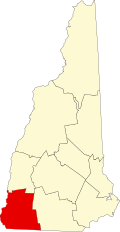Willard Homestead | |
 | |
| Location | Sunset Hill Ave., Harrisville, New Hampshire |
|---|---|
| Coordinates | 42°56′30″N72°9′21″W / 42.94167°N 72.15583°W |
| Area | 2.2 acres (0.89 ha) |
| Built | 1787 |
| Architectural style | Cape cottage |
| MPS | Harrisville MRA |
| NRHP reference No. | 86003249 [1] |
| Added to NRHP | January 14, 1988 |
The Willard Homestead is a historic house on Sunset Hill Road in Harrisville, New Hampshire. Built about 1787 and enlarged several times, it is notable as representing both the town's early settlement history, and its summer resort period of the early 20th century. The house was listed on the National Register of Historic Places in 1988. [1]


